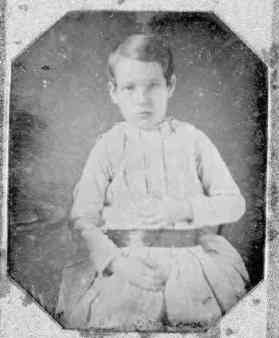
Figure 1.--Some images are obvious. This child's short hair clearly identifies him as a boy in a Degerotype probably taken in the 1850s or early 1860s. He wears a dress with a colored sash. Note the distinct side part. |

|
Photographic images are extremely valuable historical information. Drawings, paintings, and written documents can be mistken for a variety of reasons. Photograph are basically definitive statements. They show what boys actually wore rather than an artists intrpretation. There are some limitiations associated with photographs. Chilren could be dressed up in costumes rather than their actual clothing. The vast majority of photographs, however, show boys wearing their actual clothes. The greatest problem, however, is that large numbers of photographs are undated and the individuals not identified.
One of the difficulties we have in using photographs to assess youngr boys' fashions is that they were often dressed iun what we woul consider today t be girlish styles. As so many available photographs do noy identify who the individuals are, this is a serious problem. Obviously, we can not use the photograph to describe boys' fashions unless we can be sure the
Determining the gender of old images is not the only problem HBC faces with unidentified images. It is also very difficuklt to be
sure about the date of old images. The lack of a relaible date makes it hard to assess fashion trends. The pgotographic recor beginds in the 1840s. There are a few earlier photograpgs, but very few of boys. Larger numbers of photographs, however, do not begin to appear until the 1860s. By the 1870s it was increasingly common to have portraits made and the photographic record becomes much more complete. In 1900 thanks to George Eastman, snapshots begin to appear in numbers.
The bulk of the images on HBC are American, British, or German. We are, however, gradually expanding our coverage of other countries. Often we know the nationality of the available images, in part because they are identified or because of where they were found. Generally images found in America are American photographs, but this is not always the case. In Europe it becomes more difficult to identify images. This is especially the case in the smaller countries. There are, for example, great similarities between Belgium and France and the Netherlans or enmark and Germany. There are also often substantial regional differences as late as the early 20th century.
One aspect of historic clothing that the old black-and-white photographs do not provide is color. Some boys clothing is rather dark muted colors, black, greys, and dark greens, blues, and browns. Not all clothing are these colors. Unfortunately the black and white photography gives the impression that the clothes worn by boys were these muted colors.
Estimating ages is easier than determining gender or country, but there is no way of being precise. Some old photographs have names and ages on the back. Unfortunately most do not. We have tended to estimate ages roughly by the way the children look and are dressed. Our general approach is to make an estimate and then adjust if if readers have any comments and differences of opinion. Of course children vary at any age. Some children look younger or older than they look. Generally we think our age estimates are within about 1 year of the actual ages. But of course we have surely made some errors. Please let us know if you see a mistake that you beliee we have made. There are also more methods of assessing age with considerable precession. This involves body proportions, but it is often difficult to assess when the children are standing erect so that proportions can be compared. Artists sometimes use similar approaches.
There are some limitiations associated with photographs. Children could be dressed up in costumes rather than their actual clothing. HBC believes, however, that the vast majority of photographs show boys wearing their actual clothes. The greatest problem, however, is that large numbers of photographs are undated and the individuals not identified. Even then there are difficulties. Almost all early images are portraits of boys dressed in their best clothes, not what they may have normally worn. Early images are also much more likely to show boys from the more affluent families--rather than the larger number of boys from average families. These problems become of less concern after family snapshots from amateur photographers began to appear in quantities beginning in 1900. There are, however, ways of assessing these unidentified images. They are not fool proof indicators, but they are helpful in assessing these images.
Navigate the Boys' Historical Clothing Web Site:
[Return to:Main photography page]
[Introduction]
[Activities]
[Biographies]
[Chronology]
[Cloth and textiles]
[Clothing styles]
[Countries]
[Topics]
[Bibliographies]
[Contributions]
[FAQs]
[Glossaries]
[Images]
[Links]
[Registration]
[Tools]
[Boys' Clothing Home]
Navigate the Boys' Historical Clothing Web Site:
[Sailor suits]
[Sailor hats]
[Buster Brown suits]
[Eton suits]
[Rompers]
[Tunics]
[Smocks]
[Pinafores]
